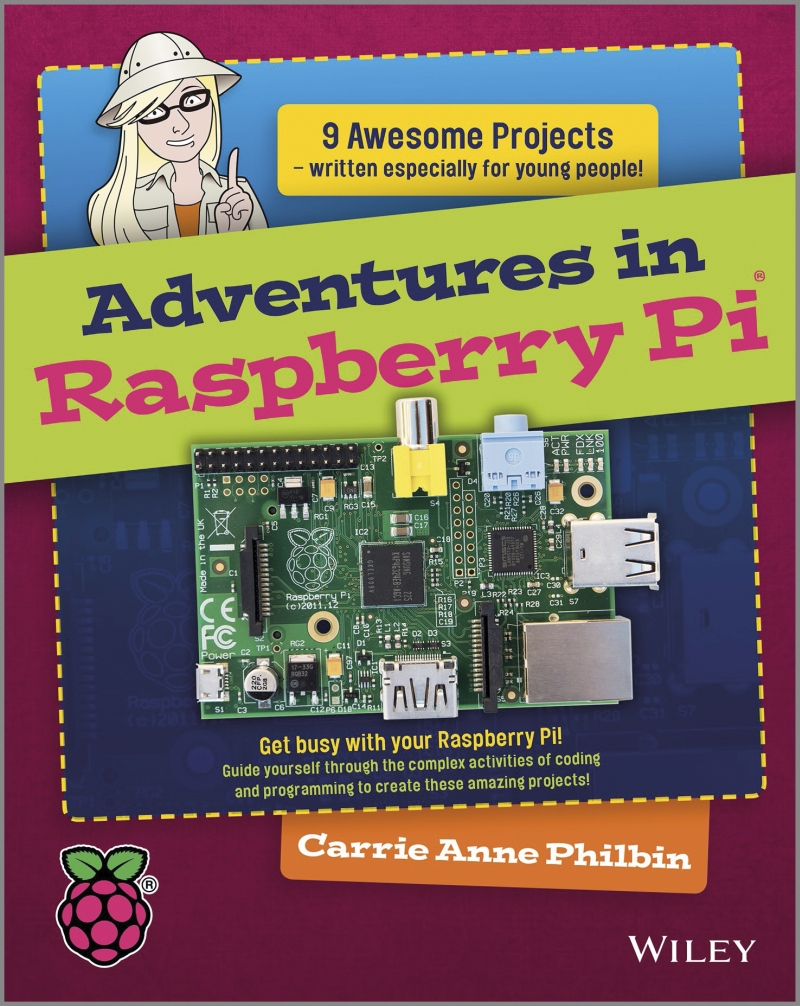
At the December CamJam, I was lucky enough to buy a copy of Adventures in Raspberry Pi, the new book by Carrie Anne Philbin, award-winning teacher and now Education Pioneer at the Raspberry Pi Foundation. I’ve taken some time to have a read through it, so here comes the review.
The book takes you from putting your Pi set-up together for the first time, through programming concepts and finally to a full electronics project. It starts with a brief, but vital, explanation of how the book is written. This includes describing how the book is laid out, with examples of the different break-out boxes, and a guide to what you can expect to learn. It also introduces the concept of reward ‘badges’ that you earn on your “adventure” through the world of Pi. The idea of taking an ‘adventure’ is obviously aimed at kids, which is great, because that is the intended audience (although frankly what full-grown adult doesn’t enjoy going on an adventure!?)

Soon enough, the book introduces you to the world of the Scratch visual programming environment and progresses through simple exercises designed to help you learn as you go, including a rather nifty RPG game. As you enter chapter adventure 4, the author uses Turtle programming to explain how you can transfer your knowledge from Scratch into the text-based programming language Python. Chapter 5 moves over to Python completely and it’s here that things start to get a bit more complicated as concepts like conditions and loops are introduced and expanded upon.
There is an entire chapter on Sonic Pi, which is a simple programming language to produce sounds with the Pi. Using the programming concepts you’ve learned, you can create your own musical compositions. Sonic Pi is a great way of showing that programming concepts are transferable and this is an extremely valuable, not to mention fun, chapter.
The remaining chapters introduce the GPIO pins and take you from a rather fun exercise involving a marshmallow through to creating a full-fledged jukebox on a breadboard. The learning curve here is pretty steep, but the author explains everything clearly and there are plenty of summaries and glossaries to explain the terms you will encounter. One thing I was particularly impressed with was the clarity of the warnings about plugging wires into your Pi. Full credit, though, to the author that she covers this in a book written for kids as I think other books wouldn’t have gone near the GPIO with a long wire. Only by exploring the GPIO pins can people understand the power of the Pi and it’s great that there’s a beginners book that takes you this far into your exploration.

At the back of the book is a comprehensive glossary of the technical terms you’ve encountered and a select list of links to further resources. The author could have listed many more links here, but the ones she has chosen are very good and by sticking to just a few she can highlight the best.
So, in conclusion all I can say is that the book is blessed with an easy-going, but ultra-clear, style of writing. Carrie Anne Philbin has created a beautiful book that deserves a place on any Pi owners bookshelf.
There’s only one score I can give to this book: 10/10
Buy the book from Wiley (the publishers), the Raspberry Pi Foundation Swag Store or from Amazon.

[…] recantha At the December CamJam, I was lucky enough to buy a copy of Adventures in Raspberry Pi, the new […]